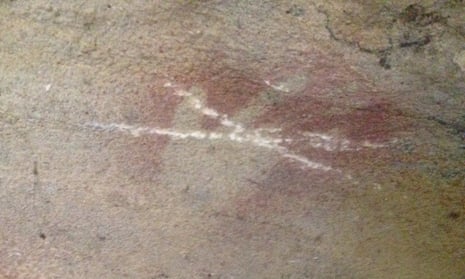Vandals have destroyed a sacred Aboriginal site in Tasmania by scratching out hand stencils which traditional owners say were made during large clan gatherings up to 8,000 years ago.
Two ochre stencils on a cave wall in the upper reaches of the Derwent valley were found destroyed by members of Tasmania’s Aboriginal community on the eve of Sorry Day, which marks the anniversary of the Bringing them Home report into the stolen generations.
Clyde Mansell, chairman of the Tasmanian Aboriginal Land Council, said the stencils were believed to have been made between 800 and 8,000 years ago by members of the teen toomele menennye, or Big River people, on their way down through the Central Highlands to the meeting site of kutalayna in the Derwent valley.
The site, called nirmena nala, is one of just 10 hand stencil sites left in Tasmania, and last year was partly handed back to the Aboriginal community by Hydro Tasmania, along with five acres of the surrounding bushland.
It has five stencils, but three have faded over time and are very difficult to find. Of the two clearest, one has now almost been completely scratched out.
“To us that site is a sacred site, and what makes it sacred is the way in which it was used, and the process that went into making those hand stencils,” Mansell told Guardian Australia.
“It means that the elders have ground up the ochre, ground it with kangaroo blood, to blow out of their mouth over their hands to leave the outline.
“It’s not just a hand stencil, it’s the story that goes with the hand stencils that turns it into a sacred site. If we can’t protect that hand stencil, then we can’t keep it in our interpretation for generations to come.”
Mansell said it was “devastating” to have the site destroyed “by none other than cultural vandals”.
The Tasmanian premier, Will Hodgman, who is also the Aboriginal affairs minister, said the damage was “a shameful act which I utterly condemn”.
“It’s difficult to imagine what could motivate someone to undertake such a senseless act, but that will hopefully come to light following a police investigation,” he said.
The damage to the hand stencil comes as the Hodgman government is appealing a federal court decision against the reopening of four-wheel drive tracks on the west coast. The tracks were closed in 2012 to protect fragile middens (refuse pits) and in February the federal court ruled the area held “outstanding heritage value to the nation.”
Kutalayna, the meeting place, was buried in the Brighton Bypass, which was approved by Labor and opened in 2012. Adam Thompson, heritage officer for the Tasmanian Aboriginal Centre, said the neglect of Aboriginal heritage by successive governments had “encouraged some elements of the Tasmanian community to think that they can wreak this type of senseless damage with immunity”.
“Individuals know that there are few penalties if they go out and destroy our heritage,” he said in a statement.
Mansell said protections offered under the state’s Aboriginal heritage legislation, the archaically named Aboriginal Relics Act 1975, were woefully insufficient.
“The Aboriginal Relics Act is all about the 1876 belief that Aboriginal culture should be the way that it was … we are not talking about sticks and stones here, but that’s that’s the way it’s worded,” he said.
“Aboriginal heritage is a living cultural experience and it includes songlines, it includes stories.”
Hodgman said the penalty for damaging the site was six months’ jail, or a $1,500 fine, but acknowledged the Relics Act was “outdated and inadequate”. The heritage minister, Matthew Groom, has been tasked with consulting with the Aboriginal community to address the “deficiencies” in the legislation, a task his father, Ray Groom, also undertook while premier in 1995.
However, the changes proposed by Ray Groom, after what the Aboriginal community still holds up as a how-to guide for cultural consultation, were never enacted. An attempt, with many changes considered unacceptable by the Tasmanian Aboriginal Centre, was put in the form of the Aboriginal Heritage Protection bill 2012, but that stalled in the upper house in 2013.
In a meeting with Matthew Groom and Hodgman on Thursday, Mansell urged them to “dust off Ray Groom’s report, and go back to what was a very respectful, consultative process”.

Comments (…)
Sign in or create your Guardian account to join the discussion